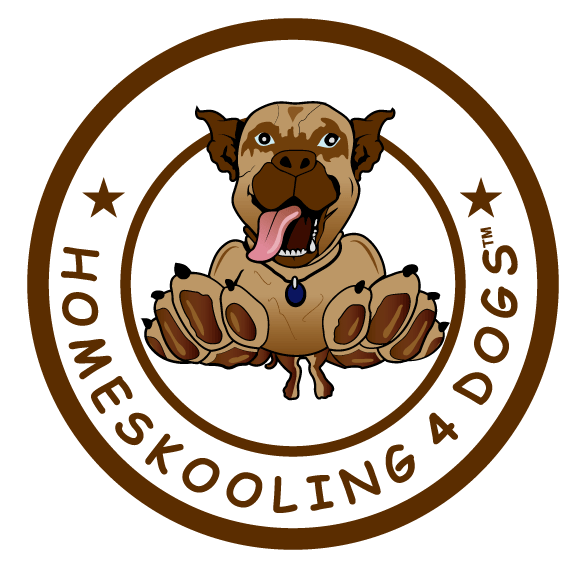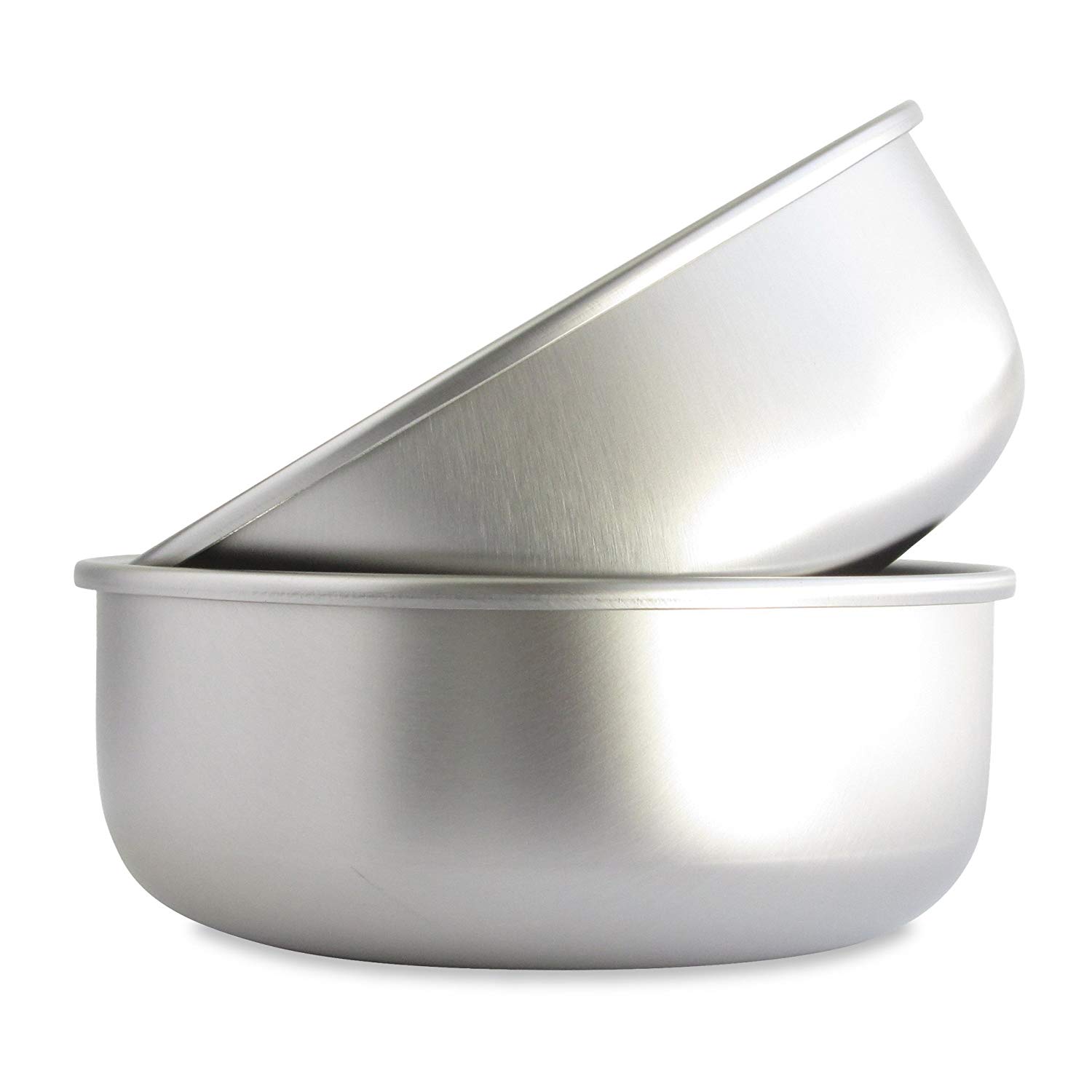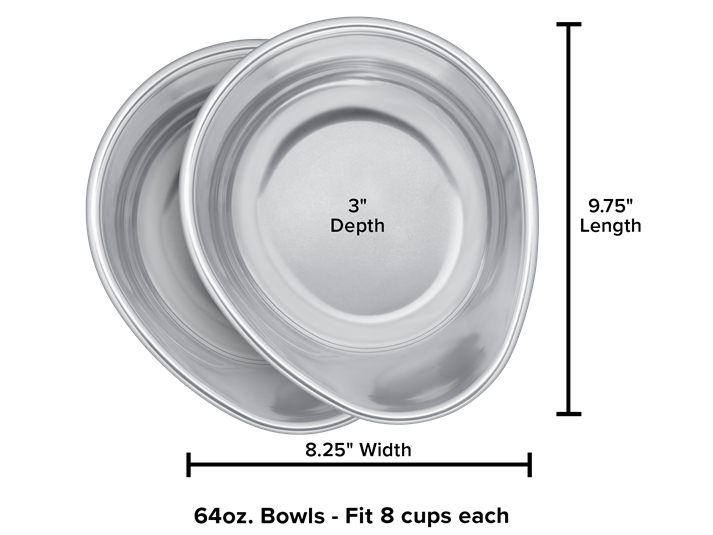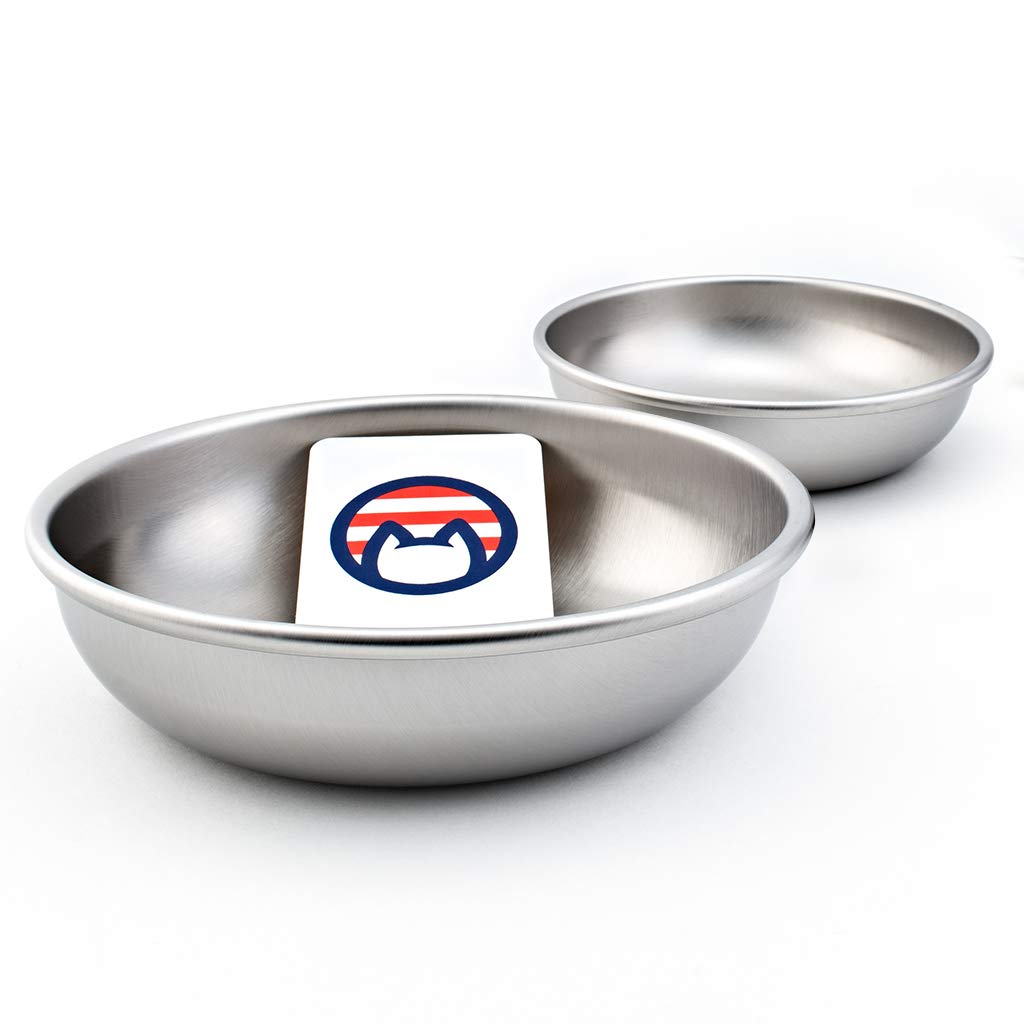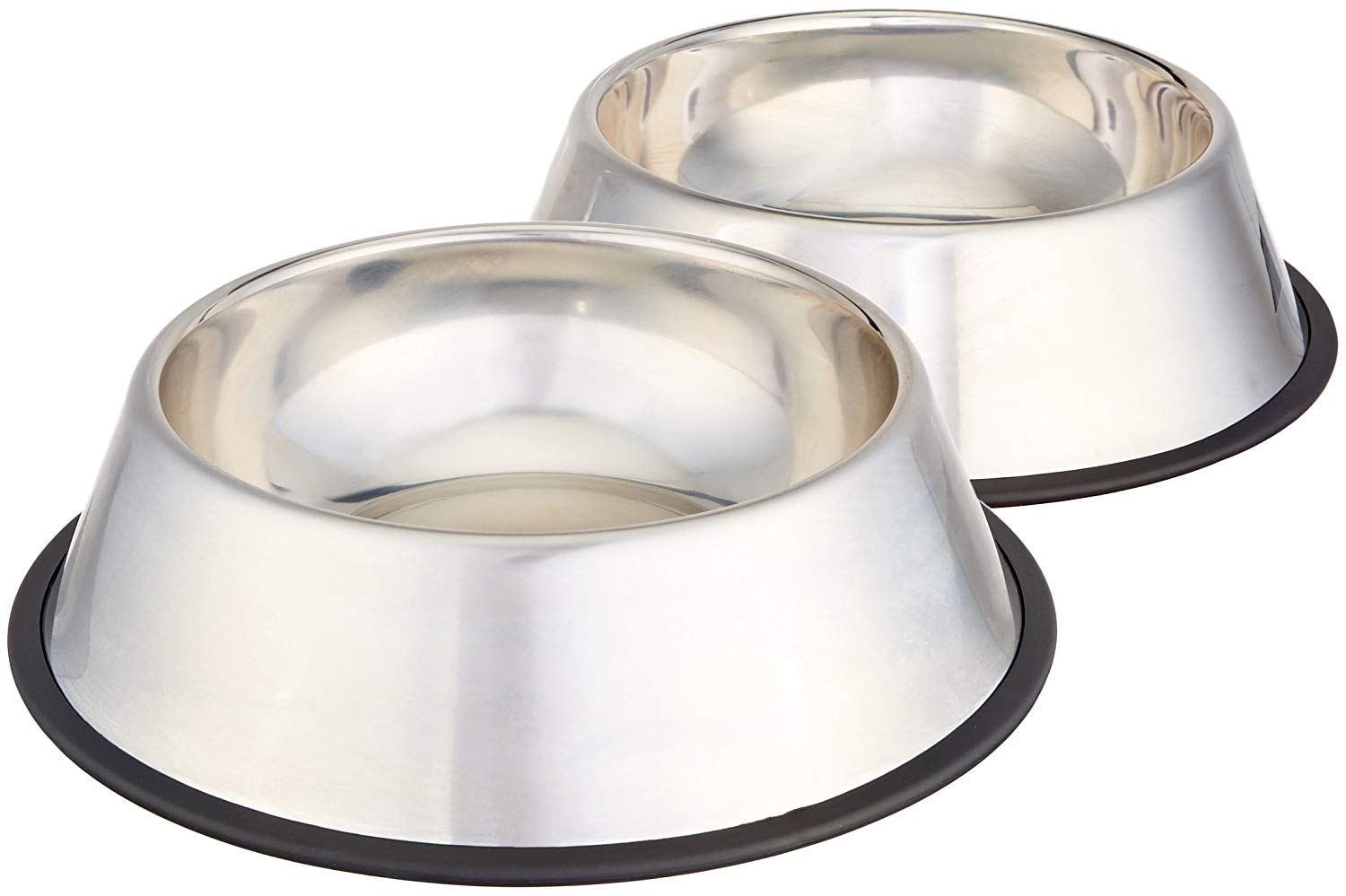Food & Water Bowls
How much water should a healthy dog drink?
Best Food & Water Bowls
Cleaning Bowls
How Much Water?
Water Safety & Filters
“statistics suggest that the plastic bowl material maintains the highest bacterial count after 14 days. Several medically important bacteria were identified from the bowls, including MRSA and Salmonella, with the majority of species being identified from the ceramic bowl. This could suggest that harmful bacteria may be able to develop biofilms more successfully on ceramic materials.”
I believe the best choice for food and water bowls is stainless steel. “It revealed that dangerous bacteria was more likely to thrive in plastic and ceramic bowls than those made from stainless steel.” [5] Plastic, stoneware or ceramic bowls can scratch and the crevices can harbor bacteria. Foreign-made ceramics can contain high levels of lead that can leach, and plastic, and aluminum bowls can also leach and contaminate bowls. [1] Stainless steel will also harbor bacteria and needs to be cleaned at least once a week. (See below) The sticky film in the bowl is biofilm (bacteria or fungi) and needs to be cleaned regularly. [8] Glass is easy to clean but there is always the chance of it breaking.
“It turns out that plastic dog bowls can cause a nasal dermatitis aptly called Plastic Dish Nasal Dermatitis. It is a loss of pigment on the nose and possibly around the mouth due to the chemical p-benzylhydroquinone which is in many plastics.” [4]
“PLASTIC DISH NASAL DERMATITIS This is a localized form of depigmentation that affects the nose and lips. It is caused by eating out of plastic and rubber dishes that contain the chemical p-benzylhydroquinone. This chemical is absorbed through the skin and inhibits the synthesis of melanin, the substance that produces dark pigment in the skin. The involved skin may also become irritated and inflamed.” [7]
But just selecting stainless steel bowls is not a guarantee of quality as we learned years ago when Petco recalled (imported) stainless steel bowls containing small quantities of radioactive cobalt-60. So consider our TOP CHOICES that are USA made human grade stainless steel as shown below.
Petco Recalls Radiation-Tainted Pet Food Bowls
FDA ALERT: Ceramicware Due to Excessive Lead and/or Cadmium “Continued surveillance of imported ceramicware intended for food use is warranted. Emphasis should be placed on those items designed to hold liquid foods.”
Top Choices
These three companies make quality human grade bowls made in the USA. All are listed to be free from lead, mercury, cadmium. WeatherTech bowls are NSF Certified and are the lowest price of the brands.
Basis Pet https://www.basispet.com/collections/all
Americat Company https://americatcompany.com/collections/frontpage
WeatherTech https://www.weathertech.com/products/pet-accessories/
Imported stainless steel is not a top choice but I believe it is a far better option than plastic or ceramic.
Cleaning dog bowls
Wash the food and water bowls regularly to remove the biofilm from saliva that can harbor salmonella in the bowls. [2]
“If you have a pet in your home, you probably need to know that pet dishes were found to be the fourth germiest place in the homes analyzed.”
“To Clean: Pet dishes should be washed daily, either in a sanitizing dishwasher or scrubbed by hand with hot soapy water, then rinsed. If handwashing, place the dishes in a bleach solution of half a tablespoon of household bleach (typically 5-8 percent active ingredients) in one gallon of water and soak for about 10 minutes once per week. Rinse thoroughly and allow to air dry.” [6]
How Much Water?
Total water intake will be influenced by drinking, the amount and moisture content of the food, temperature, physiologic state, and physical activity.
Canned, fresh, or raw foods on average contain between 65-80% moisture (water), and dry food about 9%.
Estimates of the amount of water varies.
“As a rule of thumb, dogs should drink approximately one ounce of water per pound of body weight each day” https://www.petmd.com/dog/nutrition/evr_dg_the_importance_of_water
“The average amount of water for a dog or cat to drink each day is roughly 1 cup per 10 pounds of body weight.” http://www.vetstreet.com/our-pet-experts/is-my-pet-drinking-enough-water
“Healthy adult dogs need roughly the equivalent of their energy requirement in kcal metabolizable energy (ME)/day, expressed in ml/day” Small Animal Clinical Nutrition, 5th Edition e.g. 50 lb dog eating 1166 calories a day = 39oz
How Much Water Should Your Dog Be Drinking? by Dr. Karen Shaw Becker
Water Safety
Filters & Water Treatment Systems
Home Water Treatment System Selection
CDC Choosing Home Water Filters & Other Water Treatment Systems
NSF Standards for Water Treatment Systems
“Keep in mind that certification to an NSF/ANSI standard or protocol does not mean that a filter, purifier or treatment system will reduce all possible contaminants. It’s important to verify that the filter, purifier or treatment system is certified to the applicable standard for the reduction of the contaminants of most concern to you or your family. Review our step-by-step guide on selecting home water treatment systems for more information.” http://www.nsf.org/consumer-resources/water-quality/water-filters-testing-treatment/standards-water-treatment-systems
Water containing less than 500 ppm (Parts Per Million) TDS (total dissolved solids) is considered acceptable for human drinking water and is recommended for dogs and cats. Small Animal Clinical Nutrition, 5th Edition
Why I Don’t Recommend Alkaline Water for Dogs and Cats
EWG Filter Guide: https://www.ewg.org/.../water-filter-step-by-step-guide.php
Tap Water Database: https://www.ewg.org/tapwater/search-results.php...
Dehydration / Overheating (Get Medical Help)
Heavy panting
Tongue and mucous membranes bright red
Saliva is thick and tenacious
Vomits
Dry mount
Sticky gums
What to do if Dehydration or Overheating
https://healthypets.mercola.com/sites/healthypets/archive/2019/02/03/pet-food-and-water-bowls.aspx
Plastic, Stainless Steel, Stoneware, Silicone or Ceramic Bowls? By W. Jean Dodds, DVM on February 17, 2019
The Two Germiest Pet Items in Your Home
[1] Dr. Earl Mindell’s Nutrition And Health For Dogs Earl Mindell, R.Ph., Ph.D. and Elizabeth Renaghan
[2] DOG Watch Vol. 16, No. 10 October 2012 The Environment’s Impact on Nutrition
[3] http://www.nsf.org/newsroom/help-your-pet-live-safer
[4] What Is Lurking in Your Dog's Water Bowl?
[5] Life-threatening bacteria thrives in pets’ water bowls, Hartpury experts discover
Microbiological Assessment of Canine Drinking Water and the Impact of Bowl Construction Material
FDA Import Alert 52-08 Ceramicware
[6] NSF Cleaning the Germiest Home Items
[7] Eldredge, Debra M.. Dog Owner's Home Veterinary Handbook. Turner Publishing Company.
Find information on any (almost) topic or for specific products.
start your search here: “Search”
e.g. ants, behavior problems, collars, dog food, fleas, harnesses, health, housetraining, marking, medical, separation anxiety, socialization, toys, vaccinations, whistles, yellow spots on lawn, etc.. (You get the idea)
